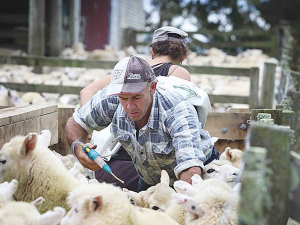Turning data into dollars
If growing more feed at home adds up to $428 profit per tonne of dry matter to your bottom line, wouldn’t it be good to have a ryegrass that gets you there quicker?
 About 30% of the pastures in New Zealand will not provide an adequate selenium intake for grazing livestock.
About 30% of the pastures in New Zealand will not provide an adequate selenium intake for grazing livestock.
Assessing the trace element status of a flock should be part of your animal health programme.
There are four important trace elements to consider in New Zealand sheep flocks. These are selenium (Se), copper (Cu), iodine (I), and cobalt (Co).
A trace element deficiency will impact on ewe (and ram) fertility, as well as the health and growth of lambs.
In some situations, a trace element deficiency may be subclinical or marginal and, therefore, can only be detected by collecting the appropriate blood and liver samples for trace element and/or enzyme determinations.
As most trace element deficiencies occur in lambs, prevention is the best approach. To prevent white muscle disease (Se), swayback (Cu) and goitre (I), treat the ewe in early gestation with Se, Cu and I. Preventing Co deficiency is the exception – lambs are best treated with vitamin B12 at docking.
In this article we will look at Selenium – Se.
Selenium
About 30% of the pastures in New Zealand will not provide an adequate selenium (Se) intake for grazing livestock. The main role of Se is as an antioxidant to protect the integrity of the cell membranes. It also maintains the integrity of the immune system.
Clinical signs of selenium deficiency
• Poor lamb growth rates.
• Infertility in ewes as a result of embryonic mortality, which occurs three to four weeks after conception. This results in a higher percent of barren ewes and a low lambing percentage.
• Poorer motility and increased morphological defects in ram sperm.
• White muscle disease in lambs, characterised by a non-inflammatory degeneration or necrosis of the skeletal and cardiac muscles. Lambs are born dead or die suddenly within few days of birth.
Selenium deficiency diagnosis
Sheep grazing pastures with 100 nmol/L reflect deficient, marginal and adequate selenium status, respectively. Some vets use blood glutathione peroxidase activity, and the respective values for deficiency and adequacy are 3.0kU/L @25 degrees C. Liver selenium concentrations of 450 nmol/kg fresh tissue reflect deficient, marginal and adequate Se status, respectively.
Preventing SE deficiency
[Warning: Use only one of the following approaches to prevent selenium deficiency, otherwise selenium toxicity could become a serious problem.]
Inject ewes and rams subcutaneously in the neck region with a long-acting product containing barium selenate four weeks before mating.
The dose is 50mg Se (1mg Se/kg LW). This will increase the selenium status of the ewe during gestation and lactation; the effect being the selenium status of their lambs will be increased from birth to weaning or time of slaughter.
Lambs do not have to be supplemented with selenium, since treating the ewe protects the lamb from white muscle disease and ensures good growth rates until at least weaning.
If ewes have not been treated and their lambs are selenium deficient, then they can be treated at three to four weeks of age at docking time. The dose is 12mg Se (1mg Se/kg LW) and its efficacy is for at least 10 months.
Oral dosing of 5mg of selenium (0.1mg Se/ kg LW) as sodium selenate to ewes and rams at four weeks before mating. The ewes again at four weeks before lambing, and a further 2mg Se to their lambs at docking. Lambs will require further drenching at 6-8-week intervals to maintain selenium status.
Top-dress in the autumn with 0.5 or 1kg of selenium prills to provide 10g Se/ha annually.
The ewes (and rams) must graze a selenium-treated pasture for a minimum of eight weeks; namely four weeks pre-mating and the following four weeks during mating.
Their lambs are likely to need a further 2mg selenium at docking. Preferably, ewes should be grazed on selenium-treated pasture for at least 16 weeks.
From a management point of view, after applying the selenium-amended fertiliser, the pastures must not grazed for at least four weeks, to allow the Se to be ‘washed’ into the soil and taken up by the pasture.
Dose ewes with one 10g Se bolus (iron) pellet, four weeks before mating.
• Information from Beef+Lamb NZ factsheet: ‘Trace element nutrition of sheep’. Next issue Copper, Iron and Cobalt
The National Wild Goat Hunting Competition has removed 33,418 wild goats over the past three years.
New Zealand needs a new healthcare model to address rising rates of obesity in rural communities, with the current system leaving many patients unable to access effective treatment or long-term support, warn GPs.
Southland farmers are being urged to put safety first, following a spike in tip offs about risky handling of wind-damaged trees
Third-generation Ashburton dairy farmers TJ and Mark Stewart are no strangers to adapting and evolving.
When American retail giant Cosco came to audit Open Country Dairy’s new butter plant at the Waharoa site and give the green light to supply their American stores, they allowed themselves a week for the exercise.
Fonterra chair Peter McBride says the divestment of Mainland Group is their last significant asset sale and signals the end of structural changes.

OPINION: Your old mate welcomes the proposed changes to local government but notes it drew responses that ranged from the reasonable…
OPINION: A press release from the oxygen thieves running the hot air symposium on climate change, known as COP30, grabbed your…